John Bernunzio’s Presentation on Vintage Instruments, January 21, 2013
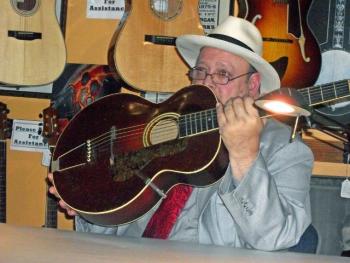
With thirty-five years experience in the vintage instrument business and with obvious expertise and enthusiasm, John Bernunzio elaborated for a group of about two dozen guitar enthusiasts on the age-old question, “Is it valuable or is it just old?“
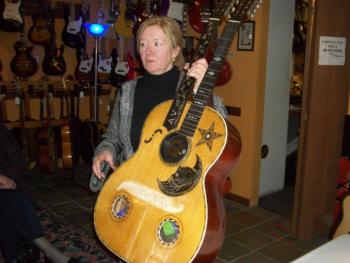
John began accumulating trumpets and banjos as well as other instruments long ago during the 70’s in his farm house near Canandaigua. We heard how he got into the business quite by accident trying to free up space in his house near Canandaigua.He made up a list of the instruments he owned and, putting them up for sale, was surprised to find that they quickly sold. bringing in enough for him to make some badly needed house repairs.
.
.
.
In those days, old instruments were affordable and of good quality, often better than the new instruments available at the time. This is not true today when new instruments are more affordable and of better quality than antiques . Of course, there have been major adjustments in the market due to recent financial setbacks.
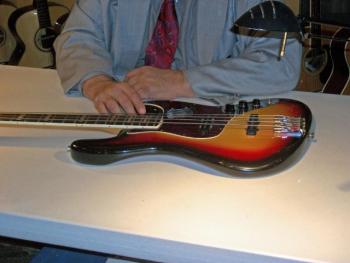
Why are some instruments valuable? Two factors are of major importance: scarcity and desirability. Instruments are desirable not only for their quality, but also because they recall one’s youth. There is a magical feel to an old instrument from bygone days. All collectibles, such as cars, recordings and coins have this quality.
.
.
.
Older instruments are not necessarily more valuable. Sometimes the materials used may have been inferior due to a shortage while shortcuts were taken by manufacturers especially during wartime. Also, some materials have become unavailable due to legislation, e.g., ivory since 1917 and Brazilian rosewood in recent years. One has to be constantly vigil for fakes, especially of more desirable items.
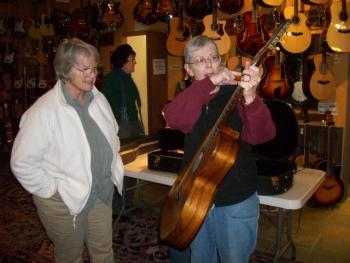
The evening turned out to be an “Antiques Road Show” of sorts for stringed instruments, mostly guitars: Seeing what folks brought in was entertaining and educational in itself, not to mention John’s informed comments on each instrument.
Unusual handmade items included two harp-guitars. One of these which is currently being repaired was from Naples, NY. It had an highly ornate soundboard and unusual sound-hole configuration. The other one, brought in by RGC member Kathy Madigan, appeared to have originally been a harp-guitar having three extra bridge holes, presumably for the extra bass strings. This instrument was made by a friend’s father around 1915 from solid Brazilian rosewood.
Popular manufacturers were also represented, Martin by a 1970’s era twelve-string and a lightweight 1940’s D-28 bluegrass and folk guitar. Gibson models included a 1952 J-50 owned by another Club member, Jeremy Carter. In addition, there were two 1930’s era Gibsons, an L-1 archtop jazz rhythm guitar with huge neck and short scale length as well as a early 30’s flattop, 12-fret model.
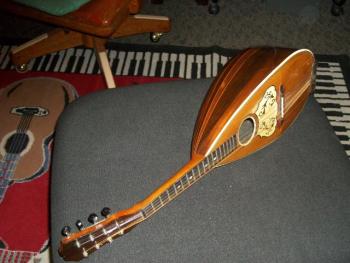
Other interesting items included a recent model resonator guitar and a Fender Precision Bass.
Besides the guitars, there were a couple of old fiddles and a bowlback mandolin made of Brazilian rosewood with a cedar top. John also showed off a couple of his better banjos, a 20’s era collector’s item and an Eastman model from China with a lightweight resonator ring.
Those of us who brought along an instrument or two for an informal evaluation were not disappointed. John performed an on the spot, and spot on, critique of the quality and approximate asking price for each instrument, often confirming details that the owner already knew. In addition to John’s expertise, we were treated to Kinloch Nelson trying out several of the guitars.
John assured us that he is frequently stumped by something he has never seen before. This is part of the charm of the business. His final advice was to buy for playability before speculation.
See more pictures here. Click on a photo to view the caption.
~R. Taglieri
Share this page: ![]() Facebook
Facebook
![]() Del.icio.us
Del.icio.us
![]() StumbleUpon
StumbleUpon
![]() Digg
Digg
![]() Reddit
Reddit
Home ::
About Us ::
Events ::
Articles ::
Resources ::
Contact Us ::
Links
©2007-2012, Rochester Guitar Club, All Rights Reserved, This page last updated 2015-02-07 12:34:40
Website by Red Beagle Web Development.








